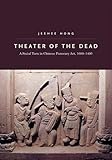Theater of the Dead : A Social Turn in Chinese Funerary Art, 1000-1400 / Jeehee Hong.
Material type: TextPublisher: Honolulu : University of Hawaii Press, [2016]Copyright date: ©2016Description: 1 online resource (248 p.) : 74 color illustrations, 27 b&wContent type:
TextPublisher: Honolulu : University of Hawaii Press, [2016]Copyright date: ©2016Description: 1 online resource (248 p.) : 74 color illustrations, 27 b&wContent type: - 9780824855376
- 9780824855406
- 792
- online - DeGruyter
- Issued also in print.
| Item type | Current library | Call number | URL | Status | Notes | Barcode | |
|---|---|---|---|---|---|---|---|
 eBook
eBook
|
Biblioteca "Angelicum" Pont. Univ. S.Tommaso d'Aquino Nuvola online | online - DeGruyter (Browse shelf(Opens below)) | Online access | Not for loan (Accesso limitato) | Accesso per gli utenti autorizzati / Access for authorized users | (dgr)9780824855406 |
Frontmatter -- Contents -- Acknowledgments -- PRELUDE: Theater in Two Worlds -- 1. THEATER AND FUNERAL -- 2. THEATER FOR THE DEAD -- 3. THEATER OF THE DEAD -- 4. THEATER, BODY, AND PASSAGE -- POSTLUDE: A Social Turn in Chinese Funerary Art -- Appendix -- Notes -- Glossary -- Bibliography -- Index
restricted access online access with authorization star
http://purl.org/coar/access_right/c_16ec
In eleventh-century China, both the living and the dead were treated to theatrical spectacles. Chambers designed for the deceased were ornamented with actors and theaters sculpted in stone, molded in clay, rendered in paint. Notably, the tombs were not commissioned for the scholars and officials who dominate the historical record of China but affluent farmers, merchants, clerics-people whose lives and deaths largely went unrecorded. Why did these elites furnish their burial chambers with vivid representations of actors and theatrical performances? Why did they pursue such distinctive tomb-making? In Theater of the Dead, Jeehee Hong maintains that the production and placement of these tomb images shed light on complex intersections of the visual, mortuary, and everyday worlds of China at the dawn of the second millennium.Assembling recent archaeological evidence and previously overlooked historical sources, Hong explores new elements in the cultural and religious lives of middle-period Chinese. Rather than treat theatrical tomb images as visual documents of early theater, she calls attention to two largely ignored and interlinked aspects: their complex visual forms and their symbolic roles in the mortuary context in which they were created and used. She introduces carefully selected examples that show visual and conceptual novelty in engendering and engaging dimensions of space within and beyond the tomb in specifically theatrical terms. These reveal surprising insights into the intricate relationship between the living and the dead. The overarching sense of theatricality conveys a densely socialized vision of death. Unlike earlier modes of representation in funerary art, which favored cosmological or ritual motifs and maintained a clear dichotomy between the two worlds, these visual practices show a growing interest in conceptualizing the sphere of the dead within the existing social framework. By materializing a "social turn," this remarkable phenomenon constitutes a tangible symptom of middle-period Chinese attempting to socialize the sacred realm.Theater of the Dead is an original work that will contribute to bridging core issues in visual culture, history, religion, and drama and theater studies.
Issued also in print.
Mode of access: Internet via World Wide Web.
In English.
Description based on online resource; title from PDF title page (publisher's Web site, viewed 29. Jul 2021)


